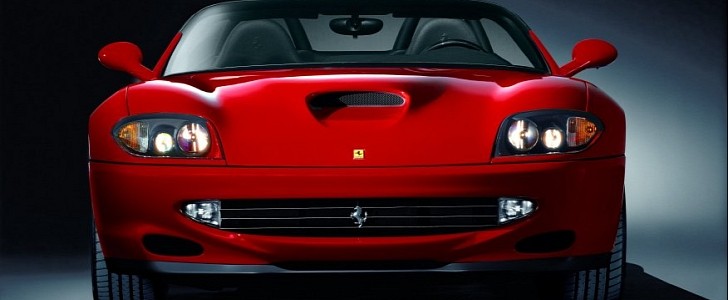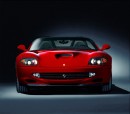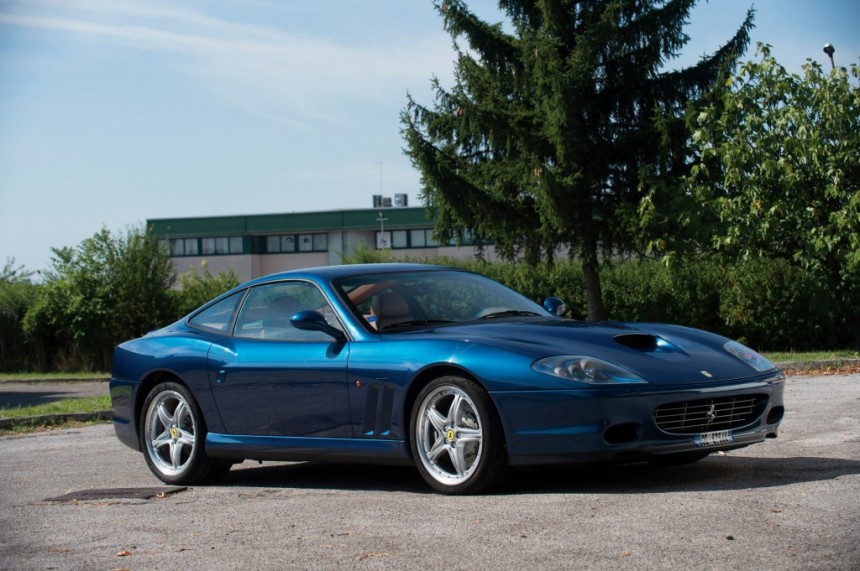Four years after the Prancing Horse launched the four-seat 456, Ferrari lifted the veils off the 550 Maranello to great critical acclaim. Just like the family-sized cruiser, the successor of the 365 GTB/4 Daytona is rocking a Dino-inspired powerplant with 456 cubic centimeters per cylinder.
Née F133, the 5.5-liter V12 with a cast-alloy block and forged-alloy pistons produces 478 horsepower (485 PS) and 569 Nm (420 pound-feet) of torque at 5,000 revolutions per minute. The reason this engine bears a different codename from the F116 of the 456 is rather simple. More specifically, this lump features redesigned cylinder heads and variable-length inlet tracts.
Tuned for low-end grunt and a little zing up high in the rev range, the seductive grand tourer weighs 1,690 kilograms (3,726 pounds), the same as the manual-equipped 456 GT. Capable of hitting 100 kilometers per hour (62 miles per hour) in 4.4 seconds, the 550 Maranello matches the 612 Scaglietti’s top speed of 320 kilometers per hour (200 miles per hour).
Named as such after the free-breathing engine’s displacement, this Fezza also impresses with its 50/50 weight distribution and 0.33 drag coefficient made possible by the flat underbody. Designed by Pininfarina and clad in aluminum alloy for the bodywork, the 550 Maranello is further gifted with composite bumpers and 250 GTO-inspired vents on the front fenders.
Penned by Elvio D'Aprile under the supervision of Lorenzo Ramaciotti, the beautiful two-seat gran turismo pays tribute to the 365 GTB/4 Daytona, too, with its cut-off tail with quad circular taillights. The first Prancing Horse without retractable headlights since 1968, the 550 Maranello also happens to be different on the inside compared to the F512 M that it replaced.
More curvaceous and luxurious as well, the V12-engined continent crusher is genuinely comfortable and far more spacious than the last incarnation of the mid-engined Testarossa. The 550 Maranello could also be had with the Fiorano Handling Package comprising of new hardware and software.
The corner-carving option brought forward uprated brakes with red calipers, stiffer springs, a 10-mm lower ride height, a thicker anti-roll bar out back, quicker steering, new toe-in and caster settings, as well as different software for the suspension. Come September 2000, the fantastic-looking model received an open-top sibling in the guise of the limited-run Barchetta.
Officially called Barchetta Pininfarina because it celebrated the coachbuilder’s 70th anniversary, this fellow numbers only 448 units. Even though it’s just as fast as the 550 over the first 100 kilometers per hour, the roadster’s different aerodynamics translate to a reduction in top speed. More specifically, the Barchetta is officially capable of 300 kph (186 mph).
Fast forward to 2002, and that’s when the Italian automaker presented the mildly refreshed 575 M Maranello. The M suffix refers to Modificato, which stresses that we’re dealing with improvements rather than a ground-up redesign. As the name implies, the most obvious improvement concerns the F133 engine, which is larger and potent than the 550’s mill.
Another huge change over the first member of the Maranello series is the optional automated manual gearbox supplied by Graziano Trasmissioni, the first road-going V12 Ferrari to feature a paddle-shift F1 tranny. Adaptive dampers on every corner, Ferodo HP1000 brake pad material, a revised interior with all the dials grouped together in a single pod ahead of the driver, and a redesigned steering wheel also need to be mentioned.
The 575 M Maranello could be had with the GTC handling package that included carbon-fiber-reinforced silicon carbide brakes, a low-restriction exhaust system, unique 19-inch wheels, and a performance-oriented suspension. Introduced in 2005, the Superamerica spruced things up with a convertible electrochromic glass panel roof that rotates 180 degrees to lie flat over the rear deck. The following year, Ferrari presented the 575 GTZ at the 2006 Geneva Motor Show with 250 GT Berlinetta Zagato styling cues.
Replaced by the 599 GTB Fiorano in 2006, the Maranello series enjoyed a 10-year production run split between 3,083 units of the 550, 448 Barchettas, 2,056 units of the 575 M, as well as 559 examples of the Superamerica.
Tuned for low-end grunt and a little zing up high in the rev range, the seductive grand tourer weighs 1,690 kilograms (3,726 pounds), the same as the manual-equipped 456 GT. Capable of hitting 100 kilometers per hour (62 miles per hour) in 4.4 seconds, the 550 Maranello matches the 612 Scaglietti’s top speed of 320 kilometers per hour (200 miles per hour).
Named as such after the free-breathing engine’s displacement, this Fezza also impresses with its 50/50 weight distribution and 0.33 drag coefficient made possible by the flat underbody. Designed by Pininfarina and clad in aluminum alloy for the bodywork, the 550 Maranello is further gifted with composite bumpers and 250 GTO-inspired vents on the front fenders.
Penned by Elvio D'Aprile under the supervision of Lorenzo Ramaciotti, the beautiful two-seat gran turismo pays tribute to the 365 GTB/4 Daytona, too, with its cut-off tail with quad circular taillights. The first Prancing Horse without retractable headlights since 1968, the 550 Maranello also happens to be different on the inside compared to the F512 M that it replaced.
More curvaceous and luxurious as well, the V12-engined continent crusher is genuinely comfortable and far more spacious than the last incarnation of the mid-engined Testarossa. The 550 Maranello could also be had with the Fiorano Handling Package comprising of new hardware and software.
Officially called Barchetta Pininfarina because it celebrated the coachbuilder’s 70th anniversary, this fellow numbers only 448 units. Even though it’s just as fast as the 550 over the first 100 kilometers per hour, the roadster’s different aerodynamics translate to a reduction in top speed. More specifically, the Barchetta is officially capable of 300 kph (186 mph).
Fast forward to 2002, and that’s when the Italian automaker presented the mildly refreshed 575 M Maranello. The M suffix refers to Modificato, which stresses that we’re dealing with improvements rather than a ground-up redesign. As the name implies, the most obvious improvement concerns the F133 engine, which is larger and potent than the 550’s mill.
Another huge change over the first member of the Maranello series is the optional automated manual gearbox supplied by Graziano Trasmissioni, the first road-going V12 Ferrari to feature a paddle-shift F1 tranny. Adaptive dampers on every corner, Ferodo HP1000 brake pad material, a revised interior with all the dials grouped together in a single pod ahead of the driver, and a redesigned steering wheel also need to be mentioned.
The 575 M Maranello could be had with the GTC handling package that included carbon-fiber-reinforced silicon carbide brakes, a low-restriction exhaust system, unique 19-inch wheels, and a performance-oriented suspension. Introduced in 2005, the Superamerica spruced things up with a convertible electrochromic glass panel roof that rotates 180 degrees to lie flat over the rear deck. The following year, Ferrari presented the 575 GTZ at the 2006 Geneva Motor Show with 250 GT Berlinetta Zagato styling cues.
Replaced by the 599 GTB Fiorano in 2006, the Maranello series enjoyed a 10-year production run split between 3,083 units of the 550, 448 Barchettas, 2,056 units of the 575 M, as well as 559 examples of the Superamerica.




























